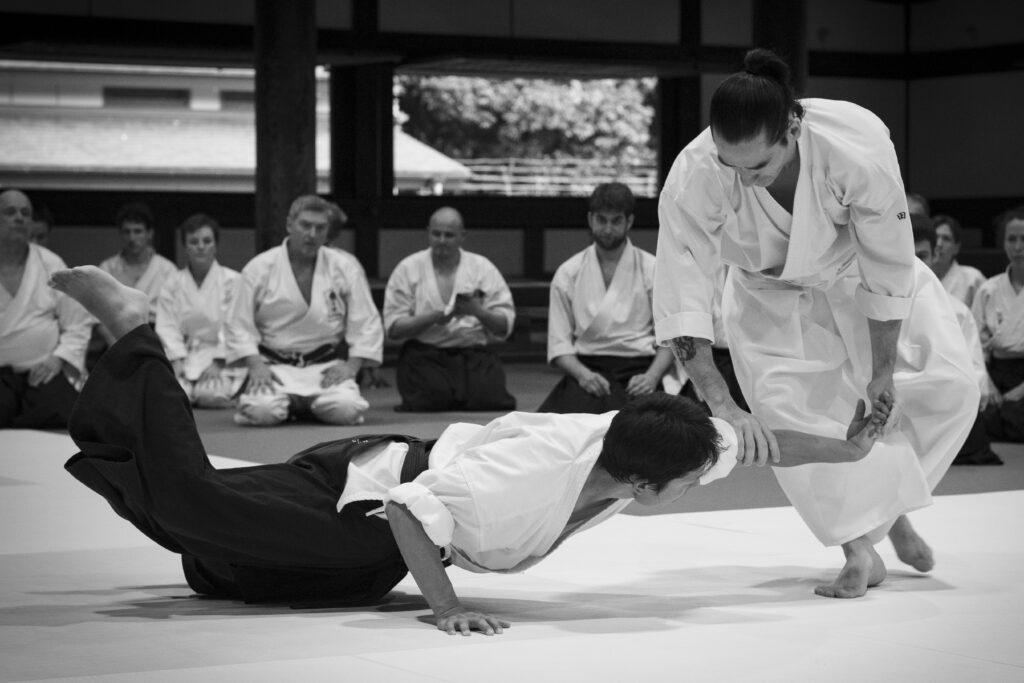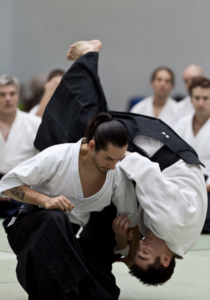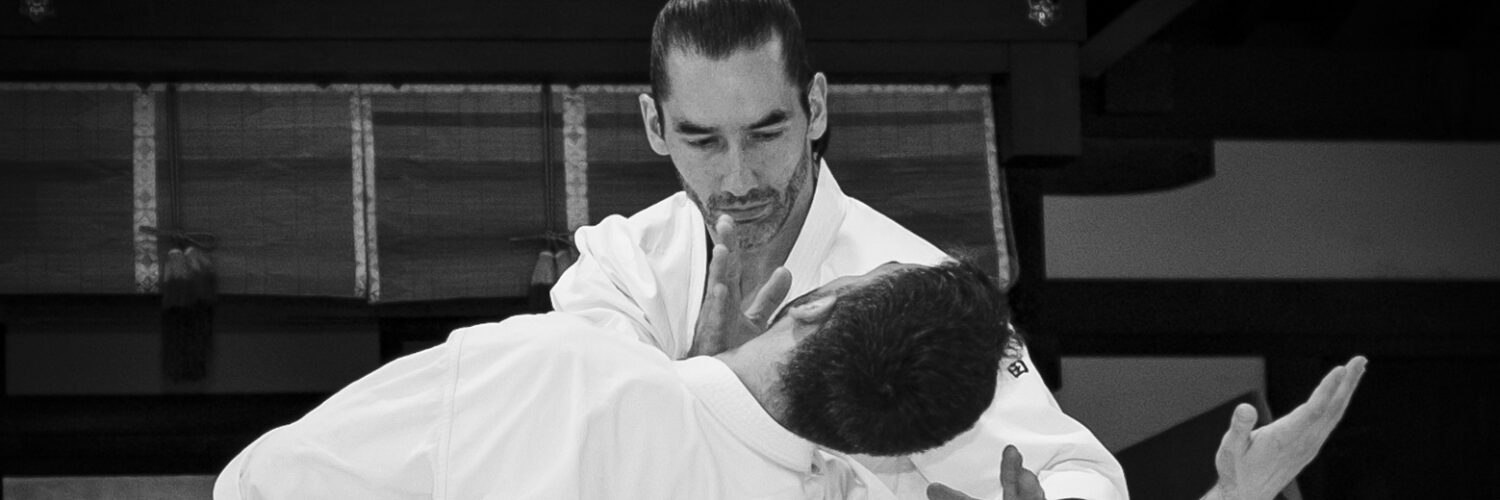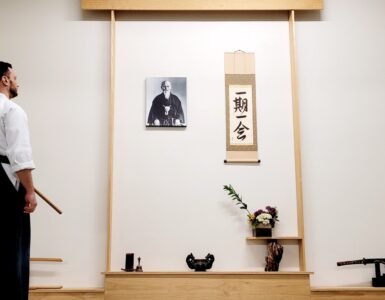Leo Tamaki began training aikido under Nobuyoshi Tamura and traveled to Japan in 1998 to train at Aikikai Hombu. He returned to France in 2001, where he opened up a martial arts equipment business and began a martial arts blog. Tamaki returned to Japan in 2007, training there for an additional three years. He later moved back to France in 2010 and took to teaching aikido full-time. He currently heads Kishinkai International and has appeared recently with Jesse Enkamp on YouTube. This is the second part of a two part interview. Read the first part here.
How would you describe your training and teaching approach?
Technically, it is the research of martial efficiency. As for the teaching part, it is a focus on principles instead of technical details. This helps because throughout the year, about 20% of the people who attend my seminars are from the Kishinkai, 20% from different martial arts like krav maga, karate, boxing, and 60% from other aikido groups. So although I could explain why we do a technique a certain way, I want to share deeper principles that students can use in their own practice. Consequently, I emphasize elements of body mechanics, strategy, distance management, mindset, and so on.

Do you teach exercises like Hino Sensei, Kuroda Sensei or Akuzawa Sensei do?
Yes. But I am extremely clear about the difference between an exercise and an application. I’ve seen many teachers, especially Japanese, going from one to another without making clear the nature of the practice. So the student don’t really know. And sometimes, even the teacher I think, is not clear.
Tell me about that video with Jesse Enkamp. How did that come about?
I knew of Jesse and had seen some of his videos. One of my friends told me that he knew of me, and was interested in making a video to share what I do.
When we met, Jesse asked me some questions, then asked if we could do a bit of sparring. I agreed and we had a pleasant exchange. Jesse was very polite, and I think he wanted to give the opportunity to show my practice in the best possible way.
How’s the reaction to the video been?
The video now has over 1.5 million views, so it seems to have raised some interest.
As for the comments and social media reaction, it’s always the same. Some people find me great; some people find me a piece of crap. In the end, people see what they want to see, more than what is in front of them.
“As for the teaching part, it is a focus on principles instead of technical details. This helps because throughout the year, about 20% of the people who attend my seminars are from the Kishinkai, 20% from different martial arts like krav maga, karate, boxing, and 60% from other aikido groups.”
And the feedback specifically from the aikido community?
Some say “People who come to aikido don’t come for martial efficiency. This is not important.” But I don’t think it’s true. Otherwise they would do pilates, yoga, or ballroom dancing. And that is why quite a few aikido practitioners were happy to see it. Because most aikido teachers wouldn’t have this kind of exchange.
I think as a Budo, even though it’s clear we’re not training to be fighters, there should be some level of martiality to the practice.
Exactly. I think budo is more than bujutsu, not different from bujutsu. You have this efficiency, but you transcend it. You don’t skip the martial effectiveness. Most of the direct students of Morihei Ueshiba understood this.

The majority of people saying “This is totally not important.” are people who cannot show you martial efficiency. If I see somebody martially effective who says, “This is not important.” then I will give an ear. But I never met any. Students in aikido are happy to see teachers who have some experience and can stand as a real martial artist.
What would you say to young people today about why they might want to get involved in some kind of martial arts training?
First of all, because of the internet and other technological advances, we live in a world where our lives are so comfortable and easy. So we became weak, impatient, and our willpower is totally degraded. But martial arts practice makes being uncomfortable a habit, teaches you focus, patience, and to develop your consciousness.
Another problem is that nowadays many people are uncomfortable, even afraid, of physical contact. Of course the Covid epidemic has been an accelerator.
“I am extremely clear about the difference between an exercise and an application. I’ve seen many teachers, especially Japanese, going from one to another without making clear the nature of the practice. So the student don’t really know. And sometimes, even the teacher I think, is not clear.”
Now we see two kids having a small fight, we have to stop them. Then call the parents. But we need to learn what physical contact is. To learn that you can be pushed. We don’t have to feel traumatized or victimized because somebody grabbed our collar or pushed us, or maybe even just said something we don’t like. Animals brawl. They bite gently, they fight playfully. How many children killed another child in a brawl? But now we don’t have this. So martial arts are more necessary than ever. They develop you. You become more flexible, more resilient and more dynamic.

Is there anything specific that aikido brings?
There is a particular ethic. In aikido, you learn to blend and return or diffuse. It’s an ethic that can be applied to everyday life in a civilized world in a very beneficial way. It helps you live better, and it is positive for everyone. So I think there is no shortage of reasons for people to practice. But it’s more and more difficult, and I’m really not confident that there will be aikido in two generations.
What makes you think so?
In France, we had 70,000 to 90,000 people practicing aikido when I started. Now there’s maybe 25,000. I’ll be 50 years old in a few months. And I don’t think you can find five people younger than me and famous in aikido. What does it mean that the youngest expert in aikido is 50 years old? So, I think aikido may simply disappear.
I’ve had conversations with people in the aikido community about this and some will say, “Well, it’s okay if it shrinks. Then you have left the people who are high quality, so that’s okay.” But regardless of the audience size, the costs are the same to make a video course, write articles or a book, or to host a seminar. But 20 years ago, there were 10 times the people who would’ve supported that thing. So, the economics to do this stuff don’t make as much sense anymore and then there are fewer professional teachers, less high-quality content, fewer large seminars, etc.
Right. If there is no event, there is no money for a professional teacher. Everybody says, “Don’t make money from aikido.” But then all the professionals who want to dedicate their lives to this, improving and training great practitioners, they disappear. This is a downward spiral.
I agree with the challenges you outline and the current state of aikido, but I also have a more optimistic outlook for the future of the art. I’ve been very encouraged by work I’ve been doing with Budo Accelerator, bringing more young people into aikido, and I’ve seen some people who have large, thriving dojos with lots of younger students. But it is the exception rather than the rule these days.
How do you think about the goal or objective(s) of your teaching?
While I consider functional applications important, it isn’t the goal of practice. For me the ultimate goal is the development of your inner and outer consciousness.
“I think budo is more than bujutsu, not different from bujutsu. You have this efficiency, but you transcend it. You don’t skip the martial effectiveness. Most of the direct students of Morihei Ueshiba understood this.”
Inner consciousness because if you want to change your body mechanics, you need to understand what your mind and body are doing. Outer consciousness is important for being able to engage spontaneously with other people. I have some students who are professional dancers or yoga teachers, and they have good inner consciousness, but not so much outer consciousness. When somebody else is not compliant, they tense up and freeze.
What we do is based on sound martial principles. But people don’t train enough to make it effective. Then again, it’s not important. Because it’s not the main objective. The essential thing is that the training allows you to develop your consciousness in the best possible way.
How has your understanding of aikido changed since your beginning in the art?
When I was 5, I went to do as my parents told me. At 12 I wanted to impress my buddies. And at 17 I thought I could pick-up girls talking about its philosophy. I want to think that my approach to martial arts has matured since those days (laughs).
When I was young, I was only looking for martial efficiency. So I had no respect for aikido. I thought that some joint locks were ok, but that it was mostly fantasy. Therefore I went into it with a lot of disdain… and got my ass kicked. It was proven to me by first-hand experience that it could be effective. Not because you’re stronger, faster, or bigger, but because you sharpen your technique and you use particular body mechanics. I then immersed myself into it.
But after years of training, while I had manage to grasp some of the martial efficiency of aikido, I began to think: “What am I doing? What is this for?” I came to the conclusion that this is about consciousness.
Can you expand on that?
You have to be present while practicing aikido. If you’re not in the moment – boom – you get hit in the head. It brings you back to the present moment.
At first, that mindfulness is in one technique. Then it’s during a whole class. And after a while it starts to spread outside the dojo. I think now it has changed me in a way where I can truly appreciate my daily life. It helps me and I think it is something that helps many people.
Everything is clearer because your consciousness is sharpened. Everything you taste and feel is more intense. Thanks to aikido practice you are more aware in your daily life. Now when I see people of every age practicing aikido and living better because of it, it also brings me great joy.
Thank you for doing your part in passing on aikido and being a champion for the art. I appreciate your candid and colorful perspective and thank you for talking the time to share it with Aikido Journal.
It’s my pleasure Josh. Thank you for the opportunity.
This is the second part of a two part interview. Read the first part here.
More information can be found on Nobuyoshi Tamura Sensei in Aikido Pioneers: Postwar Era, along with accounts from Morihiro Saito, Seiseki Abe, Katsuaki Asai, T.K. Chiba, Seishiro Endo, Masatake Fujita, Shizuo Imaizumi, Kayoichi Inoue, Hiroshi Isoyama, Mitsunari Kanai, Yasuo Kobayashi, Shoji Nishio, Mitsugi Saotome, Masando Sasaki, Kenji Shimizu, Seichi Sugano, Hiroshi Tada, Hideo Takahashi, Mariye Takahashi, Nobuyoshi Tamura, Moriteru Ueshiba, and Yoshimitsu Yamada.













I deeply appreciate Tamaki Sensei’s approach to aikido and was very inspired by how he articulated the relationship between martial efficiency and the purpose of the art: the development of inner and outer consciousness. In my own training I am trying to work on this very question. If I get too focused on my fear based concerns for martial validity, my technique breaks down and becomes less effective as I become more tense, when I focus on the present moment, the gratitude for my partner and even delight that comes from a partner’s earnest attack and what openings their attacks create, my technique works better. Not perfectly, but much better.
I also like Sensei’s openness to other arts and training with other martial artists. Cross training has allowed me to see the meaning of our art as a peacemaking art, an expression of technical/martial excellence combined with an ethical and spiritual core dedicated to the transformation of violence into harmony. I have also come to see our art as one of the most difficult ones to practice for this very reason. Technique wise, is much easier to respond to aggressive violence in ways that injure, cripple and kill than it is to respond to aggressive violence safely without hurting the opponent. To achieve this pinnacle of skill requires extraordinary training!
Aikido philosophy is not obscured by martial efficiency or martial effectiveness but illuminated by it. I would love to hear more perspectives from teachers who are exploring this dynamic.
Lovret Sensei espoused that budo begins where bujutsu ends.
I would like to thank Tamaki Sensei for sharing the work he is doing in regards to aikido and martial effectiveness. I think that his practice as demonstrated is definitely a point along the continuum towards more martial effectiveness in aikido training. I believe in gradually stepping up the level of adversity in ones aikido practice, always finding the balance between pressure and safety. I agree with the distinction that Tamaki Sensei makes between an MMA situation and no rules street fight/self-defense. Although I think that anybody who is successful at MMA most likely has developed the instincts to come up with something in a street fight. MMA professionals are like gladiators, putting themselves in very dangerous situations. So even if they were in a situation where as Tamaki Sensei discribes there are no rules (eye and groin strikes ok. Element of surprise , etc. ) most serious MMA fighters would do well because they are used to being under intense pressure and have developed their instincts to move effectively. While I am clear that I’m not training anybody to deal with MMA situations, I do feel that aikido practitioner should have good self defense skills through their training at the dojo.
I liked Tamaki Sensei’s explanation of mauai or distance saying that one needs to be outside of the range of attack or in very close. I spend a fair amount of time in my dojo working on that very principle.
This is all a work in progress and I feel it is still in it’s embryonic stage of development. I applaude Tamaki Sensei for his presentation. I feel as though we are fellow travelers. I encourage aikido instructors, especially the younger generation of full-time, aikido instructors to develop their background through some crosstraining and keep evolving aikido without losing its essence. Much thanks goes to Gold Sensei for putting this interview together and to Jesse Encamp Sensei for his work of bringing interesting topics to his venue for all of us to see.
Thanks for the insights and for contributing to the conversation Bookman Sensei!
Absolutely!
Interesting and amazing how as life edges on, remarkable connections present themselves at the right time, in the right place.
It was a fellow Aikidoka who expressed his interest in having Maître Tamaki come to our Dojo to lead seminar.
Quite a discovery, not only of someone truly invested in our Art but a remarkable human being with deep convictions and a clear view of who we are, where we are coming from, and where we are going…
A breath of fresh air and clear views for our movement in a delicate period.
I enjoyed reading the two part interview of Leo Tamaki, and learning of his history, teaching and philosophy.
I have been studying and teaching Aikido for over forty years, and also wrestle with Aikido’s effectiveness as a martial art. I want to take issue with two key points Tamaki makes in his video (which presents Aikido to a large audience – I believe he said the video received 1.5 million views.)
The first is Tamaki’s statement “I try never to do any joint lock…” and the suggestion that joint locks only work against weak people. Most of Aikido’s most fundamental techniques – ikkyo, nikyo, sankyo, shihonage, kotegaeshi – are forms of joint locks. In my experience, with proper grip and technique (which includes taking an opponent’s balance to reduce their ability to resist), they work against very strong people. I train with powerful jiu jitsu practitioners – they all tap from a strong sankyo.
Even more importantly, these joint locks allow a continued connection to the attacker, and ideally that connection will lead to a submission – the attacker “tapping” or saying “enough”. This to me is more of an Aikido ideal then striking or avoiding (which is what Tamaki does when he spars with the karate opponent.) Striking is violent with many uncontrolled outcomes. Avoiding or even throwing to the ground and losing contact allows the opponent to continue attacking.
That said, strong Aikido grips, techniques and submissions are not easy – at a higher level it also takes some adaptation, or, as Bruce Bookman Sensei says, “pressure testing”. This is where I prefer to grow my Aikido.
My belief in the ideal of Aikido ending a fight through proper technique and submission leads me to my second point. Tamaki talks about biting, kicking balls, and eye gouges. To me this is not Aikido – it is what we would resort to if Aikido did not work.
Respectfully,
Gary Snyder
Kokikai Aikido Montana